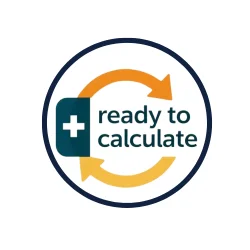Unleash the potential of proactive maintenance with our easy-to-use Planned Maintenance Percentage (PMP) Calculator. Streamline your maintenance strategy and enhance equipment reliability effortlessly.
Planned Maintenance Percentage
(PMP) Calculator
What is PMP?
Planned Maintenance Percentage (PMP) is a vital metric for assessing the success of your preventive maintenance program. It reveals the proportion of your total maintenance efforts dedicated to planned, proactive activities.
In simpler terms, PMP highlights how effectively your team adheres to the maintenance schedule while addressing potential equipment issues before they escalate into costly breakdowns.
Example: PMP in the Wind Energy Industry
Scenario: A wind farm operator aims to maintain a high PMP to minimize equipment downtime and maximize energy output.
PMP Calculation Example: If the maintenance team spends 120 hours monthly on scheduled inspections, lubrication, and minor repairs (planned maintenance) and 40 hours on emergency repairs for unexpected failures, their PMP would be:
Analysis: A PMP of 75% indicates a solid preventive maintenance strategy that addresses most issues before they lead to failures. However, there’s room for improvement. Here’s what the wind farm operator can do:
- Analyze Maintenance Data: Pinpoint components with high failure rates and adjust maintenance schedules accordingly.
- Leverage Remote Monitoring: Implement technologies to detect potential issues early and schedule preventive measures proactively.
How to Calculate Planned Maintenance Percentage (PMP)
The formula for PMP is straightforward:
Key Components of the PMP Formula
- Planned Maintenance Hours: Time spent on scheduled maintenance tasks like inspections, lubrication, and minor repairs.
- Total Maintenance Hours: The sum of all maintenance hours, including planned and unplanned work (e.g., emergency repairs).
Example: If your team logs 200 maintenance hours in a month, with 160 hours dedicated to planned activities, the PMP is:
Factors Influencing Planned Maintenance Percentage
Several factors can impact your PMP, including:
- Maintenance Strategy: A robust preventive maintenance plan with clear schedules boosts PMP.
- Equipment Age and Reliability: Older equipment often requires more unplanned repairs, lowering PMP.
- Inventory Management: Readily available spare parts expedite planned tasks, increasing PMP.
- Team Skills and Training: A skilled workforce executes preventive maintenance more efficiently.
- Data Analysis: Monitoring maintenance trends helps refine schedules and optimize PMP.
When and How to Use PMP
PMP is a powerful tool for:
- Benchmarking Performance: Track PMP trends to measure your preventive maintenance program’s effectiveness.
- Identifying Improvement Areas: A low PMP may indicate inefficiencies or inadequate maintenance planning.
- Resource Allocation: Balance preventive and corrective maintenance efforts using PMP insights.
- Cost Control: A high PMP minimizes downtime and reduces repair costs, improving overall operational efficiency.
Maximizing the Benefits of a PMP Calculator
A PMP calculator can streamline your maintenance strategy. To make the most of it:
- Input Accurate Data: Ensure planned and total maintenance hours are correctly recorded.
- Compare Industry Benchmarks: Research PMP standards in your industry to evaluate your performance.
- Set Achievable Goals: While a perfect 100% PMP is unrealistic, strive for continuous improvement over time.
Boosting Your Team’s PMP
Here are strategies to improve your Planned Maintenance Percentage:
- Develop a Comprehensive PM Program: Create detailed schedules and procedures for all equipment.
- Invest in Training: Regularly train your maintenance team on effective techniques and new technologies.
- Streamline Inventory Management: Ensure spare parts are readily available to avoid delays.
- Leverage CMMS Software: Implement a Computerized Maintenance Management System (CMMS) to track tasks, analyze data, and schedule preventive maintenance efficiently.
Conclusion
Understanding and optimizing PMP calculation is essential for effective maintenance management. By improving your Planned Maintenance Percentage, you can reduce downtime, extend equipment lifespan, and lower overall costs. Start by analyzing your current PMP, setting realistic goals, and continuously refining your maintenance strategy with the help of advanced tools and techniques.
